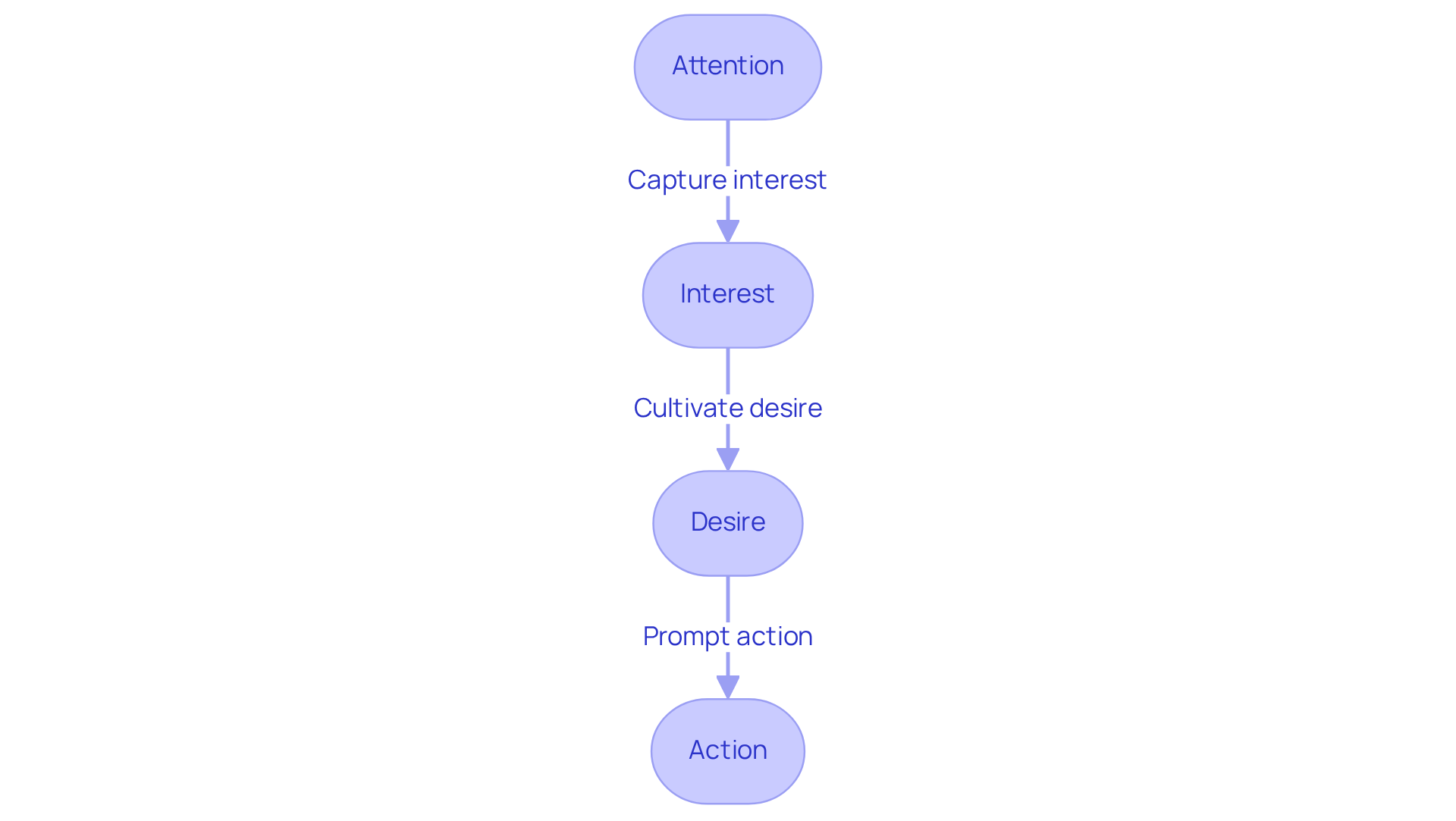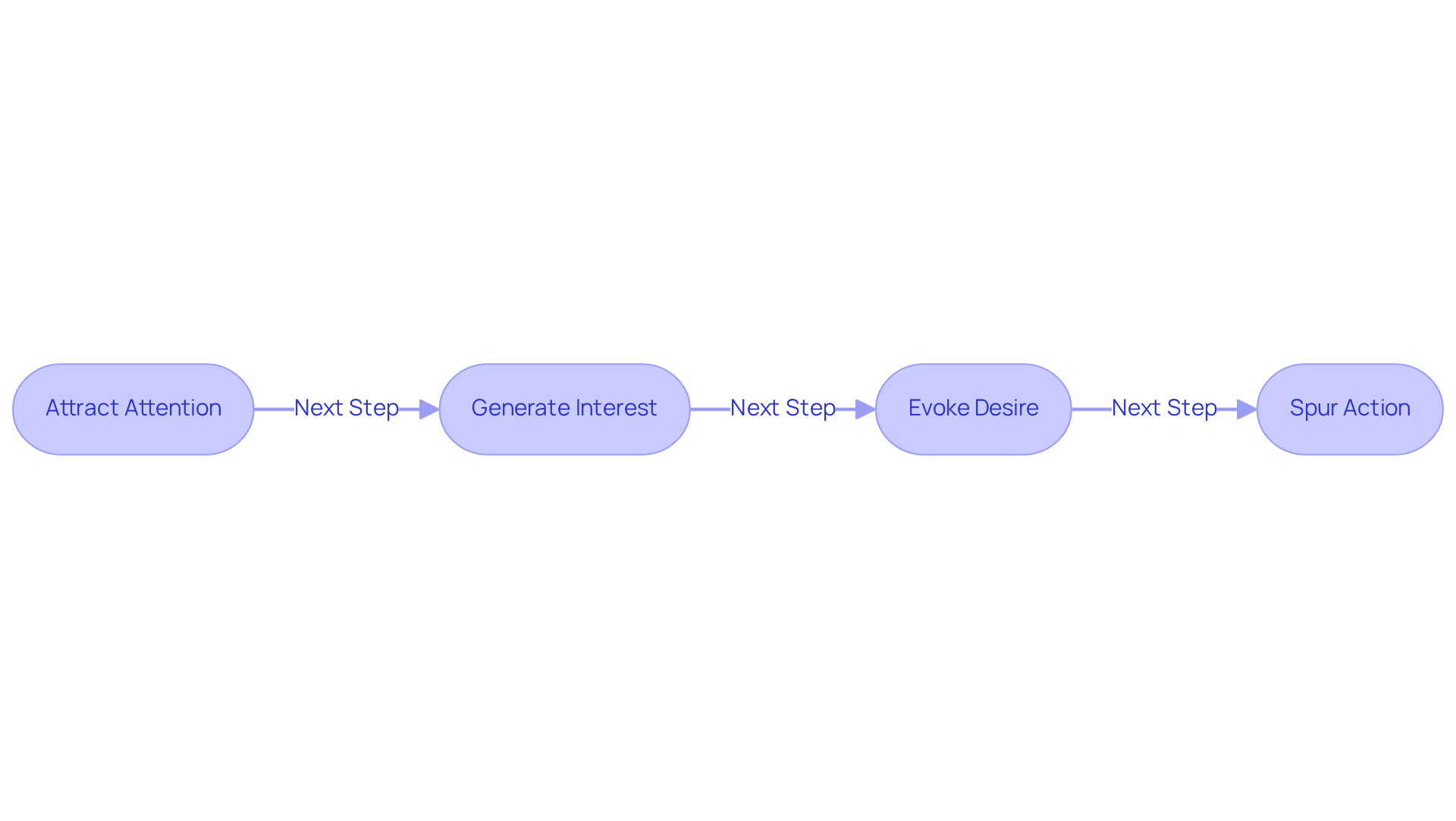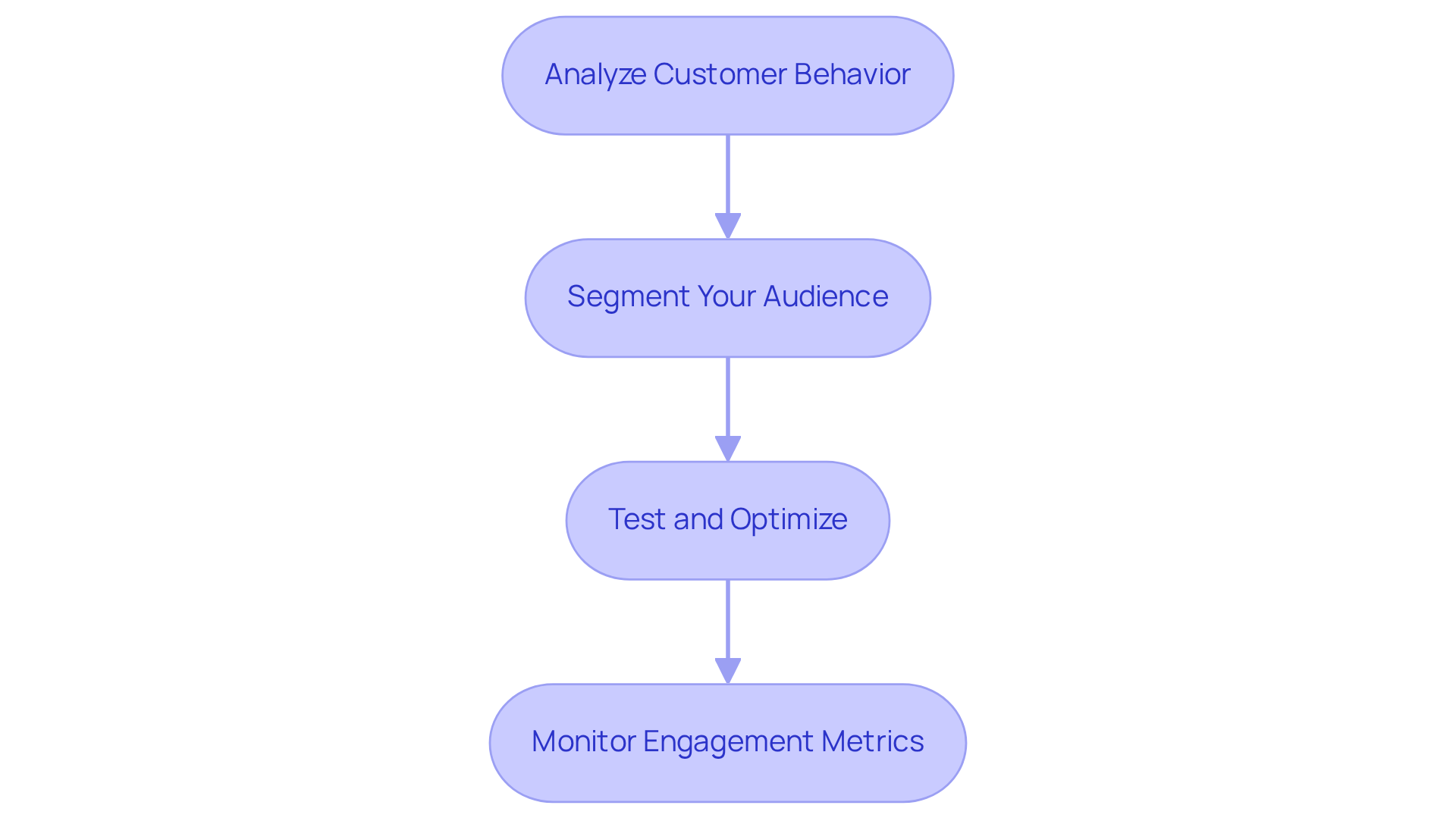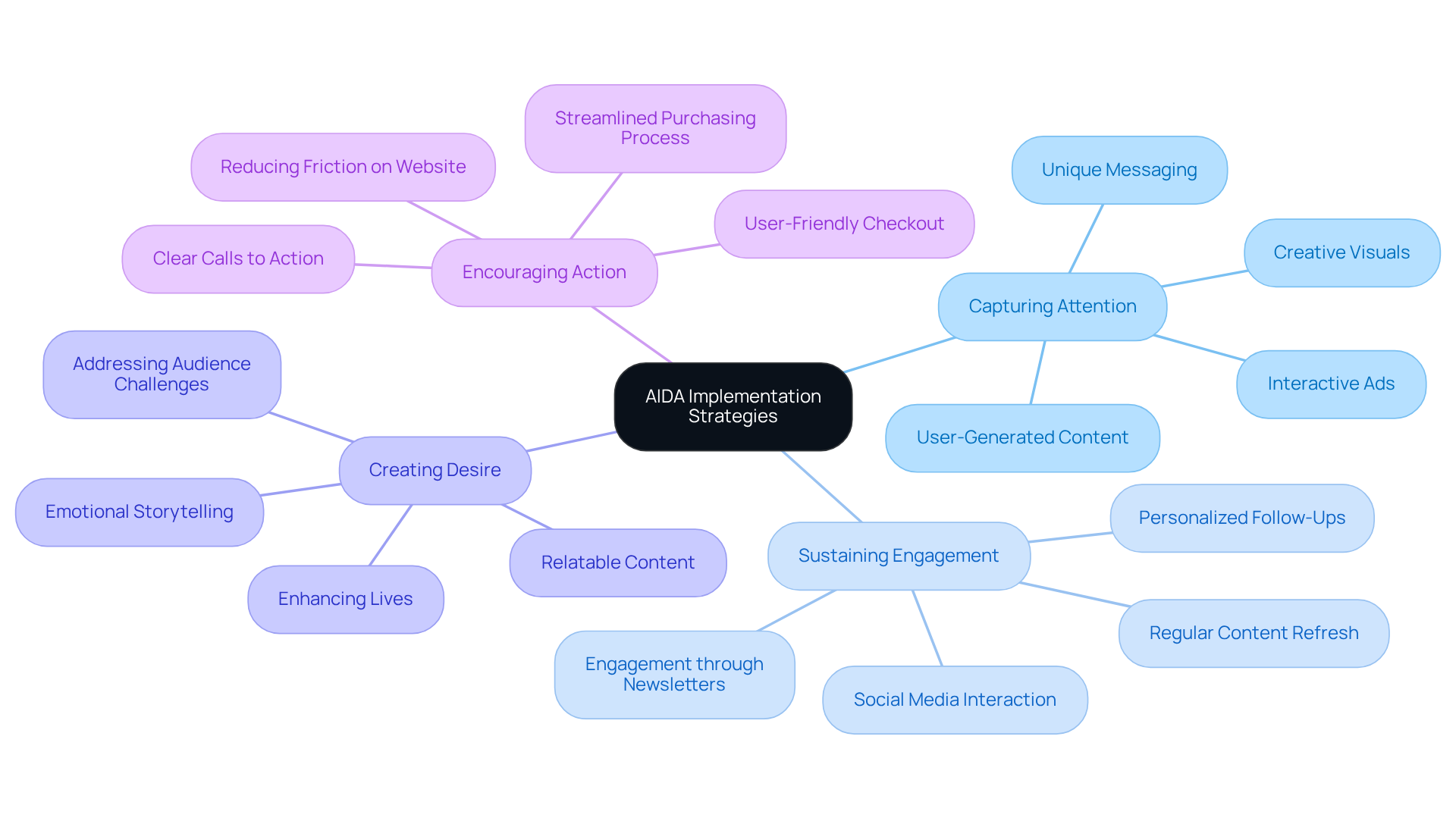
Overview
The AIDA framework stands as a cornerstone for the success of direct-to-consumer (DTC) brands, expertly guiding potential customers through the essential stages of Attention, Interest, Desire, and Action, culminating in conversions.
Effective implementation of this framework, bolstered by data-driven insights and strategies such as personalized messaging and clear calls-to-action, significantly enhances customer engagement.
In a competitive marketplace, these elements are not merely advantageous; they are imperative for driving sales and establishing a commanding presence.
Introduction
In a world where consumers are inundated with choices, capturing their attention has become increasingly challenging. The AIDA framework—Attention, Interest, Desire, Action—provides a structured approach for direct-to-consumer (DTC) brands to navigate this intricate landscape effectively. By mastering this model, marketers can enhance engagement and drive conversions in a fiercely competitive marketplace.
However, the critical question remains: how can brands ensure they are not merely adhering to the framework, but genuinely resonating with their audience amidst the dynamic shifts in consumer behaviors and expectations?
Understand the AIDA Framework: Attention, Interest, Desire, Action
The AIDA framework serves as a , consisting of four key stages: Attention, Interest, Desire, and Action. Each stage plays a pivotal role in guiding potential customers through their journey:
- Attention: The initial step centers on capturing the attention of potential customers. Marketers employ striking visuals, compelling headlines, and captivating material to distinguish themselves in a crowded marketplace. Curiosity-driven headlines and visual hooks significantly enhance the likelihood of attracting interest. As specialists emphasize, attention is the first stage in marketing; material must capture interest to be effective.
- Interest: Following the establishment of attention, the next objective is to cultivate interest in the product or service. This can be accomplished through informative content, storytelling, or by highlighting unique selling propositions (USPs). Engaging narratives and relatable scenarios resonate effectively with viewers, making them more inclined to explore further.
- Desire: At this stage, the focus shifts to fostering a strong emotional connection with the audience, compelling them to want the product. Strategies may include showcasing benefits, sharing testimonials, or instilling a sense of urgency through limited-time offers. Techniques such as social proof and fear of missing out (FOMO) amplify desire, motivating potential customers to act. Notably, companies utilizing AI-driven personalization within the AIDA framework experience up to a 20% increase in ROI, underscoring the effectiveness of this approach.
- Action: The final stage involves prompting the audience to take decisive action, whether that entails making a purchase, signing up for a newsletter, or requesting additional information. Clear and persuasive calls-to-action (CTAs) are vital in this phase, guiding customers toward the desired outcome. Effective CTAs should emphasize value and minimize friction, ensuring a seamless transition from interest to action. Furthermore, omnichannel reminder systems can boost conversion rates by 15-20%, offering marketers practical insights for effectively applying the AIDA framework.
As we approach 2025, the AIDA framework remains essential in digital promotion, particularly as brands adapt to new technologies and consumer trends. The integration of AI and data analysis into marketing strategies enhances the model's efficiency, enabling hyper-personalized campaigns that resonate with individual preferences. However, it is crucial to acknowledge the framework's limitations, including non-linear consumer behavior and the lack of post-sale engagement strategies. A practical illustration of the model in action can be observed in the case study of Calendly and DMACC, demonstrating how relatable issues and data-driven outcomes can effectively prompt consumer engagement. Marketers must prioritize attention in the customer journey, as it serves as the first step toward conversion and long-term brand loyalty.

Apply the AIDA Steps: Attract Attention, Generate Interest, Evoke Desire, Spur Action
To effectively apply the AIDA framework, follow these steps:
- Attract Attention: Capture the interest of your viewers with bold headlines, striking visuals, and engaging videos. Leveraging social media ads and influencer partnerships can significantly broaden your reach, as these channels are proven to enhance visibility and engagement. Brands that utilize TikTok, for instance, have experienced heightened customer interest due to the platform's unique material virality and commerce integration, resulting in improved visibility and brand loyalty.
- Generate Interest: Provide valuable material that resonates with your audience's needs and pain points. This could include informative blog posts, eye-catching infographics, or interactive webinars that showcase your expertise. As we approach 2025, brands are increasingly concentrating on personalized approaches that align with consumer preferences, enhancing interest and engagement. Comprehending target audiences is essential for producing content that genuinely connects.
- Evoke Desire: Create a sense of urgency or exclusivity to drive desire for your products. Utilize testimonials, compelling case studies, or to instill a feeling of necessity. Showcasing customer success stories, for example, can illustrate the tangible benefits of your product, making it more appealing to potential buyers. Highlighting limited-time offers can further enhance this sense of urgency.
- Spur Action: Implement clear and compelling calls to action (CTAs) that encourage immediate responses. Use action-oriented language such as 'Buy Now,' 'Sign Up Today,' or 'Get Your Free Trial' to motivate your viewers to take the next step. Effective CTAs are crucial in converting interest into sales, especially in a competitive DTC landscape where every moment counts. Personalized messaging can significantly enhance the effectiveness of these CTAs.

Leverage Data-Driven Insights to Enhance AIDA Implementation
To enhance your AIDA implementation using data-driven insights:
- Analyze Customer Behavior: Leverage tools like Google Analytics to gain insights into user behavior on your website. Identify high-traffic pages and analyze where users tend to drop off in the conversion funnel. This data is crucial for pinpointing areas that require improvement, enabling you to refine your marketing strategies effectively.
- Segment Your Audience: Utilize customer data to create detailed audience segments based on demographics, interests, and behaviors. This segmentation allows for that resonates with specific groups, significantly increasing engagement. According to Epsilon, personalized campaigns can make consumers up to 80% more likely to make a purchase compared to generalized efforts.
- Test and Optimize: Implement A/B testing for various elements of your marketing campaigns, including headlines, images, and calls to action (CTAs). Analyze the results to identify which variations yield the best performance. Continuous testing and optimization are essential for adapting to changing consumer preferences and maximizing conversion rates.
- Monitor Engagement Metrics: Regularly track engagement metrics such as click-through rates (CTR) and conversion rates. This data offers valuable insights into the impact of each phase of the AIDA framework, enabling you to make informed adjustments to your strategies. Companies that adopt data-driven marketing strategies, as noted by Adobe Digital Insights, often see an 80% increase in return on media spend over five years, underscoring the importance of ongoing analysis and refinement.

Overcome Challenges in AIDA Implementation for DTC Brands
To overcome challenges in AIDA implementation, consider the following strategies:
- To capture attention in a saturated market, you can utilize the by differentiating your brand with unique messaging and creative visuals. Utilize user-generated content or interactive ads to set yourself apart.
- Sustaining engagement over time involves regularly refreshing your content and utilizing the AIDA framework to engage with your supporters through newsletters, social platforms, and personalized follow-ups, ensuring they remain invested in your brand.
- Creating strong desire can be achieved by utilizing the AIDA framework, which leverages emotional storytelling and relatable content to connect with your audience on a deeper level. Emphasize how your product addresses their challenges or enhances their lives.
- Encouraging action: Use the AIDA framework to streamline the purchasing process by reducing friction on your website. Ensure that your calls to action are clear and that the checkout process is user-friendly to promote conversions.

Conclusion
The AIDA framework stands as a cornerstone of effective marketing strategies, particularly for direct-to-consumer (DTC) brands striving to excel in competitive landscapes. By mastering the stages of Attention, Interest, Desire, and Action, brands can craft compelling narratives that resonate with their target audiences, ultimately driving conversions and fostering brand loyalty.
Throughout this article, key insights have been shared regarding the effective implementation of the AIDA framework. Strategies for:
- Capturing attention through bold visuals and engaging content
- Generating interest with informative material
- Evoking desire via emotional connections and urgency
- Prompting action with clear calls to action
have all been underscored. Moreover, the significance of leveraging data-driven insights to refine these strategies has been highlighted, illustrating how analytics can enhance the effectiveness of marketing efforts.
As the marketing landscape continues to evolve, embracing the AIDA framework is crucial for brands aiming to connect meaningfully with consumers. By concentrating on personalization and adapting to changing behaviors, DTC brands can not only navigate challenges but also seize opportunities for growth. Implementing these strategies can lead to substantial improvements in engagement and conversion rates, ultimately ensuring long-term success in a dynamic marketplace.
Frequently Asked Questions
What is the AIDA framework in marketing?
The AIDA framework is a model consisting of four key stages: Attention, Interest, Desire, and Action, which guide potential customers through their journey in marketing.
What is the first stage of the AIDA framework?
The first stage is Attention, which focuses on capturing the attention of potential customers using striking visuals, compelling headlines, and captivating material to stand out in a crowded marketplace.
How can marketers cultivate Interest in their product or service?
Marketers can cultivate Interest by providing informative content, storytelling, or highlighting unique selling propositions (USPs) that resonate with the audience.
What strategies can be used to foster Desire in potential customers?
Strategies to foster Desire include showcasing benefits, sharing testimonials, creating a sense of urgency with limited-time offers, and using social proof or fear of missing out (FOMO).
What is the final stage of the AIDA framework?
The final stage is Action, which involves prompting the audience to take decisive actions such as making a purchase, signing up for a newsletter, or requesting more information.
How can marketers effectively encourage Action from potential customers?
Marketers can encourage Action by using clear and persuasive calls-to-action (CTAs) that emphasize value and minimize friction, ensuring a smooth transition from interest to action.
What role does AI play in the AIDA framework?
AI enhances the AIDA framework by enabling hyper-personalized campaigns that resonate with individual preferences, improving the model's efficiency and potentially increasing ROI.
What are some limitations of the AIDA framework?
Limitations include non-linear consumer behavior and the lack of post-sale engagement strategies, which can affect the overall effectiveness of the model.
Can you provide an example of the AIDA framework in action?
A practical illustration of the model can be seen in the case study of Calendly and DMACC, which demonstrates how relatable issues and data-driven outcomes can effectively prompt consumer engagement.
FAQs











